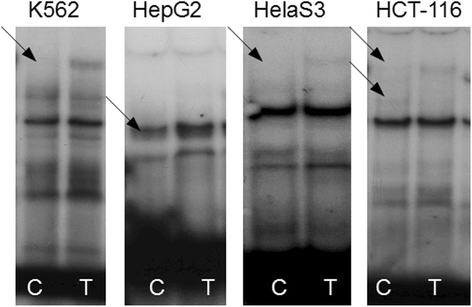Regulatory single nucleotide polymorphisms (rSNPs) at the promoters 1A and 1B of the human APC gene
- PMID: 28105931
- PMCID: PMC5249005
- DOI: 10.1186/s12863-016-0460-8
Regulatory single nucleotide polymorphisms (rSNPs) at the promoters 1A and 1B of the human APC gene
Abstract
Background: Germline mutations in the coding sequence of the tumour suppressor APC gene give rise to familial adenomatous polyposis (which leads to colorectal cancer) and are associated with many other oncopathologies. The loss of APC function because of deletion of putative promoter 1A or 1B also results in the development of colorectal cancer. Since the regions of promoters 1A and 1B contain many single nucleotide polymorphisms (SNPs), the aim of this study was to perform functional analysis of some of these SNPs by means of an electrophoretic mobility shift assay (EMSA) and a luciferase reporter assay.
Results: First, it was shown that both putative promoters of APC (1A and 1B) drive transcription in an in vitro reporter experiment. From eleven randomly selected SNPs of promoter 1A and four SNPs of promoter 1B, nine and two respectively showed differential patterns of binding of nuclear proteins to oligonucleotide probes corresponding to alternative alleles. The luciferase reporter assay showed that among the six SNPs tested, the rs75612255 C allele and rs113017087 C allele in promoter 1A as well as the rs138386816 T allele and rs115658307 T allele in promoter 1B significantly increased luciferase activity in the human erythromyeloblastoid leukaemia cell line K562. In human colorectal cancer HCT-116 cells, none of the substitutions under study had any effect, with the exception of minor allele G of rs79896135 in promoter 1B. This allele significantly decreased the luciferase reporter's activity CONCLUSION: Our results indicate that many SNPs in APC promoters 1A and 1B are functionally relevant and that allele G of rs79896135 may be associated with the predisposition to colorectal cancer.
Keywords: APC; EMSA; Luciferase reporter; Oncopathology; Promoters; Regulatory SNPs.
Figures




References
Publication types
MeSH terms
Substances
LinkOut - more resources
Full Text Sources
Other Literature Sources

